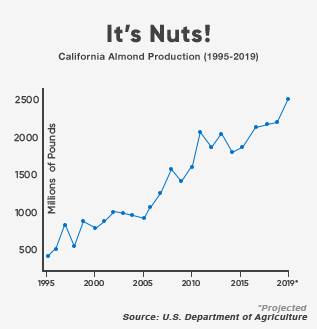Almond Demand and the Shift of Agricultural Industries

The nutrition-packed almond does more than power busy snackers. It’s shifting entire agricultural industries.
Salt is bad for you. So is fat. So is sugar. So is red meat. Or wait—maybe they’re not.
With every news cycle, it seems, dietary recommendations change. New evidence comes out contradicting last year’s advice, which contradicted advice from the year before. And if you think it’s tough for health-conscious consumers to keep up, imagine how farmers feel. The dietary decisions we make can reverberate globally across the agricultural industry. The humble almond provides the perfect lens through which to view this phenomenon.
A fondness for monounsaturated fat
In order to trace the rise of America’s favorite tree nut, we need to step back to the 1990s. The nutritional landscape looked quite different then, with “diet-friendly” treats stripped of virtually all of their fat and replaced with sugar. But as our understanding of nutrition has evolved, so have the dietary recommendations we get from all kinds of experts, including the government. Subsequent research has indicated, at least for the time being, that sugar and other carbohydrates, not fat, are largely to blame for obesity and related health issues. With this more recent information, Americans once again have embraced their love of monounsaturated fat—including foods like avocados and, yes, nuts.
As our understanding of nutrition has evolved, so have the dietary recommendations we get from all kinds of experts, including the government.
Dr. Daniel Sumner, professor of agricultural and resource economics at the University of California, Davis, can connect this shift to multiple major changes in what we grow, what we buy, and how we eat. “We’re all buying more fat these days,” Sumner notes, “including milk fat. Demand has gone up based on nutritionists saying, ‘Eat fat if you want to—it’s okay!’ And everyone said, ‘Really?! I’ve always wanted to!’” But of course, there’s a hitch. Nutritional experts suggest that plant-based fats are best for us. More and more, consumers are also thinking of food as medicine, and they’re snacking more and sitting down for meals less frequently.
The perfect snack
For each of these trends, nutritious almonds—portable, crunchable, and mild-tasting—fit the bill perfectly. They’re so perfect, in fact, that California’s almond crops are breaking records and causing agricultural “ripple effects” across the globe.
In 2022, California almond growers produced 2.6 billion pounds of almonds. In fact, an impressive 80 percent of the world’s almonds are grown in California. But those almonds aren’t consumed as whole nuts alone. Demand for almond butter, almond milk, and, more recently, almond flour has bloomed, too.

The ripple effect
As demand continues to rise, the ripple effect on almond farming is beginning to be felt further afield. Farmers are now experimenting with growing almonds in new regions like Idaho, where growers are taking advantage of cheaper land and more abundant water. Elsewhere, farmers are experimenting with new self-pollinating almond trees, as in the northwestern Australia.
Whether these crops flounder or flourish, we’re sure to see more and more of our nutrition-packed favorite nut—and more attention on eating well—in the years to come.
